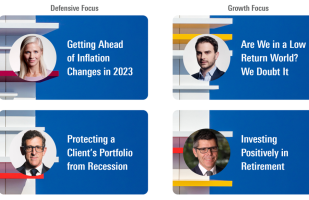
4 Stages of the Lifecycle of Advice
The constant evolution of the financial industry underscores the importance of forward thinking: time and again, we see that financial professionals and firms with the ability to adapt fare better than their counterparts. While anticipating what the future of financial advising might look like can be helpful, it’s more important to be part of the catalyst driving the change by leveraging advanced technology to offer smarter, quicker, more tailored advice.
I think that in the future, advisors’ meetings with clients are going to be more meaningful and less frequent. Clients will tap into real-time information through digital portals, and advisors will be empowered to share new insights or recommendations frequently rather than waiting for a quarterly or annual meeting.
As you focus on delivering exceptional advice to your clients, consider the four phases of the Lifecycle of Advice: building from a foundation in data aggregation to develop a goals-based plan and detailed investment recommendations, then providing oversight and monitoring.
Step 1: Data Aggregation
Smart financial advice is at the peak of a pyramid. Data serves as the base of the pyramid, but relies heavily on advisor insight (the midpoint of the pyramid) to help customers understand their data in context. Forward-thinking advice sits as the top of the pyramid, and as consumers move from raw data to advice, they rely on human interaction from advisors to guide the process and decisions.
The Lifecycle of Advice begins with gaining a thorough understanding of a client’s financial situation. For the advisor of the future, this understanding should be based on aggregated data. While clients will self-report some elements of their financial picture such as their front-of-mind investment resources, their investment goals and risk tolerances, advisors will often have to construct the rest of the picture from aggregating their own data sources and resources to develop a preliminary best-interest assessment for clients. For example, a client might have a 401(k) account from an old job that they never bothered to roll over. Or they may simultaneously have ambitious retirement goals and a six-cups-a-day latte habit that takes a significant bite out of their available resources for retirement.
Advisors who can access and interpret this data can then recommend lifestyle changes or account consolidations that might help their clients achieve their retirement goals – consolidating the neglected 401(k) under their management and growing share of wallet, or pointing out how a reduction in latte consumption could free up additional funds for retirement investing.
Step 2: Goals-Based Plan
Financial data is only worth collecting if it leads to useful insights and direction: smart data rather than big data. These insights can then inform a goals-based financial plan, a roadmap to achieving the client’s financial objectives that will ultimately inform an investment solution that helps investors complete these objectives.
Once a straightforward and objective financial plan is developed, financial advisors will continue to be the coaches, keeping their clients on track and disciplined throughout the game. We analyzed the full market cycle of the recession spanning from 2007-2015 in our Capital Sigma: Return on Advice research, and found that a deep financial planning process combined with continuous client coaching resulted in quantifiable value for clients. Out of 10,000 advisors studied, those who were able to talk their clients through emotion-based reactions to market swings and keep them consistently invested in the market outperformed the advisors who moved their clients to cash by 64 basis points each year.
Having a goals-based plan makes it easy to point to the roadmap in times of market uncertainty and keep clients on track. Modern financial technology’s ability to map performance against goals in real time can help keep both clients and advisors aware of where they stand in terms of achieving those specific goals and empower those conversations about staying on track.
Step 3: Investment Recommendations
Thoughtful asset allocation recommendations must then be developed based on the agreed-upon goals and plan. The Return on Advice research showed that advisors can add 28 basis points of value annually through ensuring that the allocations they recommend are diversified and consistent with the client’s risk profile and investment objectives.
As clients push for increased fee transparency during the onboarding process, technology can help advisors meet the fiduciary standard for account documentation and disclosures that their customers are now demanding. Advisors who are positioned to easily track disclosures and document best interest rationalizations and expenses in their systems will be well positioned for success – regardless of the eventual outcome of the Department of Labor (DOL) fiduciary rule.
Step 4: Oversight & Monitoring
Delivering, documenting and archiving client communications and disclosures will continue to be a critical responsibility for advisors. Many advisors have adopted client relationship management systems to keep information organized and help support clients as their situations change. Integrated technology can take advantage of the aggregated data collected in step one to assist advisors with everything from rebalancing portfolios to heeding compliance demands, providing real-time updates and assistance.
Looking at the future of the financial advice industry, I am optimistic about the potential for advisors to offer a new level of service, one that’s based on aggregated data, empowered with human insight and focused on what matters most to their clients.
Envestnet, Inc. (NYSE: ENV) is a leading provider of intelligent systems for wealth management and financial wellness. Envestnet’s unified technology enhances advisor productivity and strengthens the wealth management process. Envestnet empowers enterprises and advisors to more fully understand their clients and deliver better outcomes.
The opinions expressed herein reflect our judgment as of the date of writing and are subject to change at any time without notice. They are not intended to constitute legal, tax, securities, or investment advice or a recommended course of action in any given situation. Investment decisions should always be made based on the investor’s specific financial needs and objectives, goals, time horizon, and risk tolerance. Information obtained from third party resources are believed to be reliable but not guaranteed. This paper may contain ‘forward- looking’ information that is not purely historical in nature. Such information may include, among other things, projections and forecasts. There is no guarantee that any forecasts made will come to pass. Reliance upon information in this paper is at the sole discretion of the reader.



